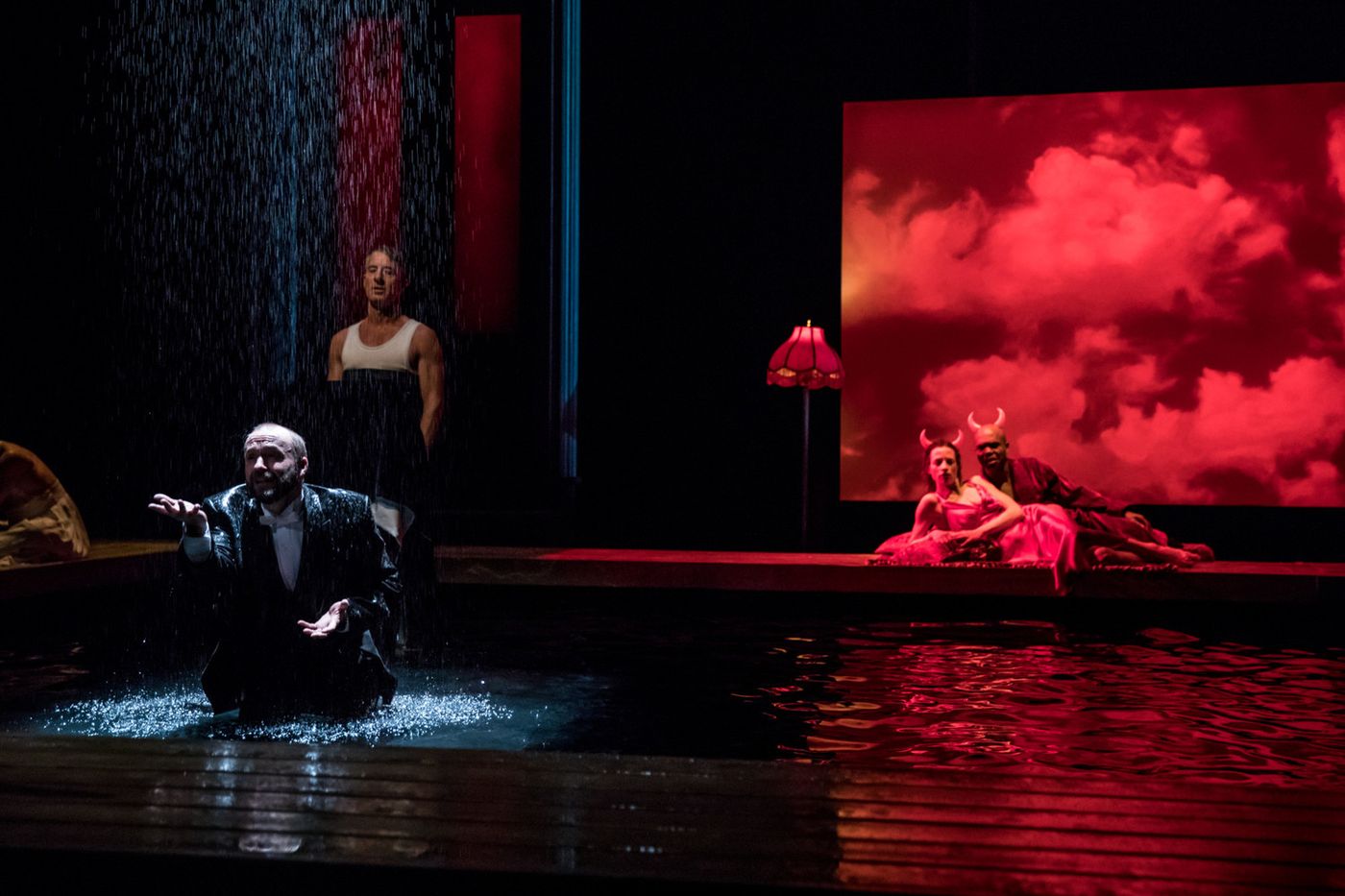Review: METAMORPHOSES at Guthrie
 "Bodies" is the first word spoken in Mary Zimmerman's adaptation of Ovid's METAMORPHOSES, and it's the physicality of the story telling that makes this show such a theatrical pleasure. First developed with students at Northwestern, the production went pro and opened on Broadway in 2002 at Circle in the Square. There it created quite a splash, literally: the first two rows of audience were supplied with disposable raincoats. Yes, that's right: METAMORPHOSES is staged in and around a pool.
"Bodies" is the first word spoken in Mary Zimmerman's adaptation of Ovid's METAMORPHOSES, and it's the physicality of the story telling that makes this show such a theatrical pleasure. First developed with students at Northwestern, the production went pro and opened on Broadway in 2002 at Circle in the Square. There it created quite a splash, literally: the first two rows of audience were supplied with disposable raincoats. Yes, that's right: METAMORPHOSES is staged in and around a pool.
The water is more than a brilliant theatrical gimmick. It is central to rituals of initiation, purification, and transformation in many cultures and religions. Essential to life, water can shape shift from steam to liquid to ice. Our bodies are composed, mostly, of water. And stepping out of the 5th floor theater space in the Guthrie's architectural triumph of a downtown building offers immediate and spectacular lobby views of the mighty Mississippi River. Currently it's at flood stage, cascading over the managed falls in the center of Minneapolis. It's the reason this city is right here.
The Guthrie's co-production with Berkeley Rep of METAMORPHOSES has just opened after its California run. Mary Zimmerman agreed to direct, again. Several members of the ensemble who appeared in the Broadway premiere are back. I saw the show in 2002 and several times since so it no longer has the shock of the new for me, but it is still among the most innovative and memorable productions of our time.
Zimmerman has kept most of the original staging, frequently blending narration by some performers with action by others, and often presenting aspects of the same scene simultaneously in several sizes: oarsmen rowing in unison while a model ship is pulled across the water and actors enact the human relationships attendant on the particular story, for instance. She happily employs humor and the occasional sight gag. When "a god sparks" he lights up a cigarette, for instance. Costumes are mostly solid color and based on classical Greek drapery accented with modern touches, like Hermes' leather motorcycle jacket with white wings painted on the back.
Midas' story frames the whole. Depicted as a besuited but barefoot father obsessed with business and profit, he hypocritically claims he is motivated by love for his family, while repeatedly shutting down his young daughter who is playing nearby. It is he who first disturbs the serene surface of the water on the word "talk." To reverse the tragedy that ensues, he must undertake a long journey, which resolves in a liquid coda and benediction following the final full story.
The ensemble of 10 actors gathered here are all Equity performers. The group includes four who did the show in New York (Raymond Fox, Louise Lamson, Felicity Jones Latta, Lisa Tejero), several Berkeley Rep regulars, some newcomers, and well-known local actor Steven Epp, who makes good use of his comic gifts. His physical strength and expressivity are essential to some of the most arresting scenes. He is frequently paired with Sango Tajima, an outsized talent in petite packaging. Her depiction of Hunger was, for me, the most gripping performance in the show.
Great and lasting theater works interact with their times. Even when productions are nearly identical, different meanings emerge in different decades. I was struck by how impossible it was to keep from hearing Trumpian notes in the Midas sequences, even though the production never promotes this with any mannerism or caricature. Perhaps because the first story called up contemporary politics for me, I was more aware on this viewing that the arc of the evening addresses income inequality as an issue. The final story tells of an impoverished but loving and righteous couple who welcome gods in disguise as strangers when wealthier households will not. More jarring for me, I was struck this time by the way the story turning on father-daughter incest is initiated by the daughter's desire, a patriarchal reversal of something we know to be the more usual pattern.
Obviously the technical demands of this show are significant, and they are managed here with the Guthrie's customary excellence. It was smart to share production costs with Berkeley Rep though the two pools had to be quite different shapes (a hexagon in California, a rectangle in Minnesota). Music, lighting, costumes, and set elements are all woven together expertly.
Zimmerman's METAMORPHOSES is a great way to introduce older tweens and teens to some of the psychologically provocative Greek myths that are foundational to Western culture. Parents should be forewarned though that it does reference sex directly (the Greek gods were a randy bunch, after all), and incest, and a segment of unapologetic full frontal male nudity.
The show runs 90 minutes without intermission and is up through May 19. There's always plenty to see; it's a visual feast, but calibrated to provide time for contemplation, too. There's lots of action in the early sequences (Poseidon and his henchmen whip up quite a storm, for instance) while later scenes tend to run longer and with a higher ratio of talk to action. I recommend this production highly, especially to those intrigued by the interplay of myth, dream, and archetype as alternate modes for making sense of reality, to those who love water or dance or storytelling, and to any who have not seen a production of METAMORPHOSES before. It's a must see.
Photo credit: Dan Norman
Reader Reviews

Videos

